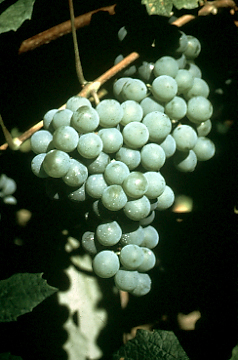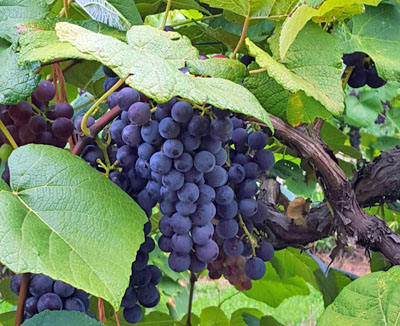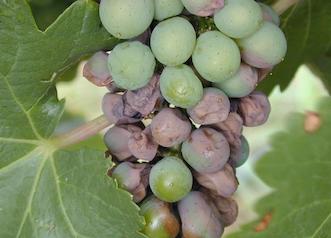Grapes: The Fruit of the Vine
By Carolyn R. Casey, Fairfax Master Gardener

Niagara grapes
Grapes, the fruit of the vine. How delighful they are and to see them growing in your garden. The next time you enjoy your favorite glass of wine or a delicious grape think about what it took to produce this wonderful fruit right off the vine. Vineyards are sprouting up all around the Virginia countryside. Let’s take a look to see just what goes into producing that good crop of grapes by these and other growers.
Buy dormant bare root or young potted plants that are grown in one gallon containers. Select plants that you can prune back to a few buds or a vigorous basal shoot to encourage a straight trunk. The European grape Vitis vinifera and the American grape V. labrusca are the primary bunch grapes grown commercially in the United States. Suggested varieties of table grapes to grow in Virginia are ‘Concord,’ ‘Delaware,’ ‘Himrod,’ ‘Mars,’ ‘Niagara,’ ‘Seneca,’ ‘Steuben’ and the ‘Sunbelt.’

American Vitis lambrusca
Grapevines are woody perennials. Plant grapevines in the early spring as soon as you can work the soil. They need full sun to produce a good harvest. Heat is also needed for the grapes to ripen. The grapevines are pollinated by wind and insects. Grapes can be used to make jelly, jam, and wine and can be eaten right off the vine.
It is good to plant grapevines 8 to 10 feet apart in rows that run north to south. This allows the fruit and leaves to be exposed to sunlight and to produce a better quality fruit. Southern locations have higher temperatures and less chance of frost. Planting your grapevines in areas that are prone to spring frosts may affect new growth in April and May. Also, plant in an area where they will be sheltered from the cold and wind. When planting grapevines you need to consider the type of cultivar you will be planting and training system you will use.
Grapevines achieve their full production harvest in their fifth or sixth year. When grapevines are properly tended, they can live from up to 50 to 100 years. They are easy to propagate but a well- established plant cannot be transplanted. So carefully consider where you want to plant your grapevines.
Young grapevines cannot compete with weeds for water and nutrients. It is important to keep the grapevines free of weeds. They can be planted through black plastic, and this reduces weed growth and increases the soil’s temperature.
Grapevines grow well in most soils with good drainage. Clay soil has poor drainage. You need to build raised beds in areas with clay soil. Grapes like a soil pH of 5.8 to 6.5, and a soil pH higher than 8.0 might create nutritional problems.
Things to consider when making decisions about your soil are tillage, application of fertilizer and organic matter, as well as planting cover crops. These factors are important and will have a lasting effect on the soil’s quality. Soil is usually the first medium in the vineyard which is manipulated so that changes can be made to promote growth patterns of the grape vines. Often the soil will be tilled to control weeds, incorporate lime, add fertilizer and to provide irrigation to the grapevines. The soil’s organic matter of vineyards in Virginia falls within the range of about 2 percent to 6 percent and is measured by oxidation of carbon. When plowing an area to break up existing hard soil, it is important to mix 16 inches of organic matter into the soil. This will increase the oxygen, water and carbon decomposing microorganisms. When using manure, decrease the rate of fertilizer in half.
You may want to train your grapevines to help them develop an established root system and trunk. When planting your grapevines, choose the strongest shoot that is growing from each newly planted vine. Train it to a stake or twine that is attached to a trellis wire so it develops a straight trunk. When the shoot reaches the wire, do not top it during the growing season but wait until it goes dormant. You will prune it at a node (through a bud) 3 to 4 inches above the desired height and tie it to the wire. After you have chosen the training you want to use, you should build a trellis for your grapevines.

Pruning tips for grapevines
There are two forms of pruning for grapevines: one is cane pruning and the other is spur pruning. Some cultivars do best when cane pruned and others when they are spur pruned. The America grape, V. labrusca, and many hybrids produce only vegetative shoots on the basal buds of canes. If these are pruned to short spurs, they produce little or no fruit. It’s best to cane prune cultivars when no specific pruning method is recommended. Proper pruning and training are needed for the production of a good high quality fruit and to keep a balance between vegetative growth and fruit yield. When pruning, you need to remove 90 percent of the wood that was produced the previous year. This pruning will make your vine more manageable and produce better fruit.
Propagating grapevines must be done from cuttings since seedlings will not have the same characteristics as the parent plant. Make hardwood cuttings late during the dormant period. This ensures that the grapevine had enough winter cold to give buds a chance to grow normally in the spring. Take the cuttings before pruning in February. Choose 1-year-old dormant canes that are healthy and grew in full sun. They should be the diameter of a pencil and should have three buds. Do not choose canes that are big and have long internodes where there are 6 inches from one bud to the next. Make a straight cut below the basal bud closest to the trunk and a slant cut in the internode above the top bud of every cutting. This helps you identify the bottom and top ends of your cuttings. This is important because cuttings will not root if planted upside down.
February cuttings can be planted into a propagation bed. Cuttings taken earlier during the dormant season need to be stored in vented plastic bags and kept in the fridge that doesn’t have any fruit for a month to give it the chilling time it needs.
Plant the cuttings 6 inches apart in rows that are 2 to 4 feet apart in tilled soil that is well-drained. Till into the top 3 to 6 inches of soil a fertilizer like 16-16-16 at the rate of one cup per 10 feet of row. When planting in one gallon pots, use potting soil and a pot with drainage holes. Plant one cutting per pot. Plant them in loose soil so the basal and center buds are covered and the top bud is above the surface. Plant the cutting right side up with the slanted cut at the top and press the soil firmly around the cuttings. Rooting hormones are not needed.
Water to maintain needed and consistent soil moisture during the grapevines’ first year. Keep the area free of weeds. Make sure that the plants that you started in containers do not become root bound. Transplant your plants in the early spring the following year.
Local climate and growing conditions will influence a cultivar’s performance so make sure that you choose cultivars that are adapted to your region. Regions differ in the minimum winter cold temperatures and summer temperatures or growing degree days. You also need to consider a cultivar’s disease and cold tolerance.

Black Rot
Diseases and Insects
You can expect to yield 20 to 30 pounds of grapes per vine when you spray for disease and insects when they appear. Grapevines stressed by drought or shade are prone to diseases like powdery mildew or botrytis fruit rot. In Virginia, the majority of common and serious fungal diseases are due to the failure to manage black rot, powdery mildew and downy mildew. In North Carolina, it was reported that rot complex caused more than a 50 percent crop loss. There are 70 species of fungi and bacteria associated with bunch rot. These include primary and secondary pathogens. Primary pathogens include the fungi causing phomopsis, black rot, bitter rot, botrytis, macrophoma rot and ripe rot. Secondary pathogens are considered wound invaders and refer to anything that rots the grapes except botrytis, black rot, phomopsis and maybe anthracnose. Late season rots is the term for ripe rot, bitter rot, macrophoma rot and sour rot.
Ways to control late season rots include cultural practices combined with fungicide applications. Fungal spores overwinter in the cordons, canes, mummies and dried leaves on the vines and the ground. Cut out dead wood on the vine, remove mummies and remove pruned canes. Also, rake up and remove leaves every fall. It is important to be aware of shoot positioning and leaf removal so that you allow sunlight and air to circulate throughout the interior of the plant. Good air circulation helps to prevent diseases.
Grapes are host plants for the Spotted Lanternfly and several other insects. This year there will be two cicada broods, and they are expected in early to mid-May. Female cicadas will lay their eggs into branches that are about the size of a pencil. This leads to the death of these branches and can be devastating to vineyards.
There are a number of diseases and insects associated with growing grapes that vineyards have to contend with from the dormant stage to fruit harvest and into postharvest.
The next time you enjoy a glass of wine, grape juice, or grape jelly or even a fresh grape from the cluster that you bought at the store. Remember to thank the farmer that grew those grapes for your enjoyment! Happy vineyard gardening.
Resources
• Grapes, Douglas G. Pfeiffer, Anton B. Baudoin, J. Christopher Bergh, Alson H. Smith, Mizubo Nita,
Horticultural and Forest Crops, Virginia Cooperative Extension, 2021
• Viticulture Notes, Tony K. Wolf, Virginia Cooperative Extension,
March-April 2006
• Viticulture Notes, Ashley Meyers, Introduction to late-season fruit rots, Virginia Cooperative Extension,
March-April 2006
• Vineyard and Winery Information Series, Vol. 21 No.1, Tony K. Wolf, Virginia Cooperative Extension,
January-February 2006
• Growing Table Grapes, Bernadine C. Strik, Oregon State University
• Grape Trellising and Training Basics, Tiffany Maugham, Brent Black, Mike Pace, Utah State University
Yard and Garden Extension
• Small Fruit in the Home Garden, Jayesh B. Samtani, Reza Rafie, Tony K. Wolf, Alson H. Smith Jr.,
Virginia Cooperative Extension
• Bunch Grapes, Marjan Kluepfel, Bob Polomski, Factsheet, HGIC1402, Clemson Cooperative Extension
Home and Garden Information Center
• Mid-Atlantic Vineyards Grape IPM, Douglas G. Pfeiffer, Virginia Tech